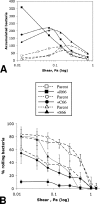Differential stability and trade-off effects of pathoadaptive mutations in the Escherichia coli FimH adhesin
- PMID: 17502398
- PMCID: PMC1932922
- DOI: 10.1128/IAI.01963-06
Differential stability and trade-off effects of pathoadaptive mutations in the Escherichia coli FimH adhesin
Erratum in
- Infect Immun. 2009 Apr;77(4):1720
Abstract
FimH is the tip adhesin of mannose-specific type 1 fimbriae of Escherichia coli, which are critical to the pathogenesis of urinary tract infections. Point FimH mutations increasing monomannose (1M)-specific uroepithelial adhesion are commonly found in uropathogenic strains of E. coli. Here, we demonstrate the emergence of a mixed population of clonally identical E. coli strains in the urine of a patient with acute cystitis, where half of the isolates carried a glycine-to-arginine substitution at position 66 of the mature FimH. The R66 mutation induced an unusually strong 1M-binding phenotype and a 20-fold advantage in mouse bladder colonization. However, E. coli strains carrying FimH-R66, but not the parental FimH-G66, had disappeared from the patient's rectal and urine samples collected from 29 to 44 days later, demonstrating within-host instability of the R66 mutation. No FimH variants with R66 were identified in a large (>600 strains) sequence database of fimH-positive E. coli strains. However, several strains carrying genes encoding FimH with either S66 or C66 mutations appeared to be relatively stable in the E. coli population. Relative to FimH-R66, the FimH-S66 and FimH-C66 variants mediated only moderate increases in 1M binding but preserved the ability to enhance binding under flow-induced shear conditions. In contrast, FimH-R66 completely lost shear-enhanced binding properties, with bacterial adhesion being inhibited by shear forces and lacking a rolling mode of binding. These functional trade-offs may determine the natural populational instability of this mutation or other pathoadaptive FimH mutations that confer dramatic increases in 1M binding strength.
Figures




Similar articles
-
The affinity of the FimH fimbrial adhesin is receptor-driven and quasi-independent of Escherichia coli pathotypes.Mol Microbiol. 2006 Sep;61(6):1556-68. doi: 10.1111/j.1365-2958.2006.05352.x. Epub 2006 Aug 23. Mol Microbiol. 2006. PMID: 16930149 Free PMC article.
-
Positively selected FimH residues enhance virulence during urinary tract infection by altering FimH conformation.Proc Natl Acad Sci U S A. 2013 Sep 24;110(39):15530-7. doi: 10.1073/pnas.1315203110. Epub 2013 Sep 3. Proc Natl Acad Sci U S A. 2013. PMID: 24003161 Free PMC article.
-
Molecular variations in Klebsiella pneumoniae and Escherichia coli FimH affect function and pathogenesis in the urinary tract.Infect Immun. 2008 Jul;76(7):3346-56. doi: 10.1128/IAI.00340-08. Epub 2008 May 12. Infect Immun. 2008. PMID: 18474655 Free PMC article.
-
Structural and functional characterization of the FimH adhesin of uropathogenic Escherichia coli and its novel applications.Microb Pathog. 2021 Dec;161(Pt B):105288. doi: 10.1016/j.micpath.2021.105288. Epub 2021 Nov 12. Microb Pathog. 2021. PMID: 34780972 Review.
-
Molecular structure of adhesin domains in Escherichia coli fimbriae.Int J Med Microbiol. 2005 Oct;295(6-7):479-86. doi: 10.1016/j.ijmm.2005.06.010. Int J Med Microbiol. 2005. PMID: 16238022 Review.
Cited by
-
A High-resolution Typing Assay for Uropathogenic Escherichia coli Based on Fimbrial Diversity.Front Microbiol. 2016 Apr 29;7:623. doi: 10.3389/fmicb.2016.00623. eCollection 2016. Front Microbiol. 2016. PMID: 27199951 Free PMC article.
-
Adhesion of Enteropathogenic, Enterotoxigenic, and Commensal Escherichia coli to the Major Zymogen Granule Membrane Glycoprotein 2.Appl Environ Microbiol. 2022 Mar 8;88(5):e0227921. doi: 10.1128/aem.02279-21. Epub 2022 Jan 12. Appl Environ Microbiol. 2022. PMID: 35020452 Free PMC article.
-
Bacterial biofilms: development, dispersal, and therapeutic strategies in the dawn of the postantibiotic era.Cold Spring Harb Perspect Med. 2013 Apr 1;3(4):a010306. doi: 10.1101/cshperspect.a010306. Cold Spring Harb Perspect Med. 2013. PMID: 23545571 Free PMC article. Review.
-
Identification of hot and cold spots in genome of Mycobacterium tuberculosis using Shewhart Control Charts.Sci Rep. 2012;2:297. doi: 10.1038/srep00297. Epub 2012 Mar 2. Sci Rep. 2012. PMID: 22389766 Free PMC article.
-
The bacterial fimbrial tip acts as a mechanical force sensor.PLoS Biol. 2011 May;9(5):e1000617. doi: 10.1371/journal.pbio.1000617. Epub 2011 May 10. PLoS Biol. 2011. PMID: 21572990 Free PMC article.
References
-
- Arbeit, R. D. 1995. Laboratory procedures for the epidemiologic analysis of microorganisms, p. 190-208. In P. R. Murray, E. J. Baron, M. A. Pfaller, F. C. Tenover, and R. H. Yolken (ed.), Manual of clinical microbiology, 6th ed. American Society of Microbiology, Washington, DC.
-
- Bouckaert, J., J. Mackenzie, J. L. de Paz, B. Chipwaza, D. Choudhury, A. Zavialov, K. Mannerstedt, J. Anderson, D. Pierard, L. Wyns, P. H. Seeberger, S. Oscarson, H. De Greve, and S. D. Knight. 2006. The affinity of the FimH fimbrial adhesin is receptor-driven and quasi-independent of Escherichia coli pathotypes. Mol. Microbiol. 61:1556-1568. - PMC - PubMed
-
- Johnson, J. R., E. Oswald, T. T. O'Bryan, M. A. Kuskowski, and L. Spanjaard. 2002. Phylogenetic distribution of virulence-associated genes among Escherichia coli isolates associated with neonatal bacterial meningitis in The Netherlands. J. Infect. Dis. 185:774-784. - PubMed
Publication types
MeSH terms
Substances
Grants and funding
LinkOut - more resources
Full Text Sources
Medical

